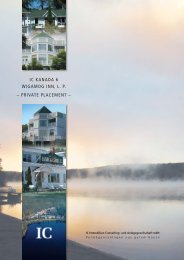mass falls in the Wachau-Danube Valley (Bohemian Massif
mass falls in the Wachau-Danube Valley (Bohemian Massif
mass falls in the Wachau-Danube Valley (Bohemian Massif
- TAGS
- mass
- valley
- massif
- www.ic-group.org
You also want an ePaper? Increase the reach of your titles
YUMPU automatically turns print PDFs into web optimized ePapers that Google loves.
The rock face of <strong>the</strong> former quarry near Dürnste<strong>in</strong> is composed of Gföhl gneiss, a f<strong>in</strong>e-gra<strong>in</strong>ed gneiss of granitic<br />
composition, which constitutes a typical rock type of <strong>the</strong> Moldanubian gneiss complex. The rock texture is<br />
characterised by schlieren, bumpy fold<strong>in</strong>g and a knobbly structure, which gives <strong>the</strong> gneiss a ra<strong>the</strong>r migmatitic<br />
appearance (Fuchs and Matura 1980). Partly slab- or lens-shaped <strong>in</strong>clusions of amphibolite with a diameter of<br />
several decimetres appear with<strong>in</strong> <strong>the</strong> gneiss. These bodies are accumulated <strong>in</strong> several horizons; <strong>the</strong>ir<br />
longitud<strong>in</strong>al axes are orientated parallel to <strong>the</strong> well-developed foliation of <strong>the</strong> gneiss. Coarse gra<strong>in</strong>ed,<br />
pegmatitic layers (muscovite) occur rarely. In some areas, <strong>the</strong> gneiss is closely folded. The strik<strong>in</strong>g directions of<br />
<strong>the</strong> fold axes are orientated NNE-SSW.<br />
Based on field tests accord<strong>in</strong>g to EN ISO 14689-1:2003 (ON 2004), <strong>the</strong> uniaxial compressive strength (UCS) of<br />
<strong>the</strong> rocks <strong>in</strong> Spitz and Dürnste<strong>in</strong>, respectively, can be estimated as “very high”, which means UCS is <strong>in</strong> a range<br />
of 100-250 MPa.<br />
Discont<strong>in</strong>uity orientation<br />
In both former quarries, <strong>the</strong> system of discont<strong>in</strong>uities is typified by well-developed bedd<strong>in</strong>g and foliation planes<br />
as well as steeply dipp<strong>in</strong>g jo<strong>in</strong>ts and slickensides. In <strong>the</strong> metamorphic rocks of Spitz, sedimentary structures<br />
such as bedd<strong>in</strong>g planes are well preserved. In contrast to <strong>the</strong> W-dipp<strong>in</strong>g foliation planes <strong>in</strong> Dürnste<strong>in</strong>, <strong>the</strong> strike<br />
of bedd<strong>in</strong>g planes <strong>in</strong> <strong>the</strong> Spitz marbles is orientated N-S to NNE-SSW (subparallel to <strong>the</strong> <strong>Danube</strong> River) and dip E<br />
to ESE, <strong>in</strong>cl<strong>in</strong>ed by 28-45°(mean: 35-40°) (Fig. 9a). The thickness of s<strong>in</strong>gle marble beds is up to 10 m; <strong>the</strong><br />
bedd<strong>in</strong>g planes are not planar, but uneven and wavy with syncl<strong>in</strong>als plung<strong>in</strong>g towards <strong>the</strong> <strong>Danube</strong> River.<br />
The foliation planes with<strong>in</strong> <strong>the</strong> Gföhl gneiss <strong>in</strong> Dürnste<strong>in</strong> and <strong>the</strong> jo<strong>in</strong>ts and slickensides orientated parallel are<br />
strik<strong>in</strong>g N-S, and dip to <strong>the</strong> W at a mean angle of 40° (Fig. 9b). The rock face of <strong>the</strong> former quarry is also<br />
exposed towards W (towards <strong>the</strong> <strong>Danube</strong> River), <strong>the</strong>refore <strong>the</strong>se discont<strong>in</strong>uities strike parallel to <strong>the</strong> rock face<br />
but dip at a lower angle.<br />
Apart from bedd<strong>in</strong>g and foliation planes dipp<strong>in</strong>g out of <strong>the</strong> rock face, at least two approximately perpendicular<br />
sets of steep or even vertical discont<strong>in</strong>uities can be found <strong>in</strong> both locations. The Spitz marbles are cut by ESE-<br />
WNW strik<strong>in</strong>g subvertical fault planes, accompanied by jo<strong>in</strong>ts perpendicular to <strong>the</strong> bedd<strong>in</strong>g planes.<br />
Fur<strong>the</strong>rmore <strong>the</strong>re are two steeply WNW- and WSW-dipp<strong>in</strong>g and NNE-SSW and NNW-SSW strik<strong>in</strong>g<br />
discont<strong>in</strong>uity sets (Fig. 10 a, b). In Dürnste<strong>in</strong>, NE-SW to NNE-SSW strik<strong>in</strong>g and very steeply NW/WNW or ESE<br />
dipp<strong>in</strong>g sets of jo<strong>in</strong>ts and fault planes (slickensides) and on <strong>the</strong> o<strong>the</strong>r hand NW-SE strik<strong>in</strong>g, very steeply NE or<br />
SW dipp<strong>in</strong>g jo<strong>in</strong>ts and fault planes (slickensides) represent <strong>the</strong> most dist<strong>in</strong>ct discont<strong>in</strong>uity sets. There are two<br />
subsets allocated to <strong>the</strong> two ma<strong>in</strong> sets, both strik<strong>in</strong>g 30° rotated counter clockwise. Both ma<strong>in</strong> sets represent a<br />
conjugate system, reflect<strong>in</strong>g a large scale tectonic pattern, <strong>in</strong> which <strong>the</strong> NE-SW strik<strong>in</strong>g discont<strong>in</strong>uities are<br />
oriented parallel to <strong>the</strong> Diendorf fault, whereas <strong>the</strong> o<strong>the</strong>r set forms an obtuse-angled strike. For this reason <strong>the</strong><br />
system of discont<strong>in</strong>uities <strong>in</strong> Dürnste<strong>in</strong> (Fig. 11 a, b) can be related to <strong>the</strong> tectonics of <strong>the</strong> Diendorf fault stress<br />
field (Scheidegger 1976).<br />
Discont<strong>in</strong>uity characteristics<br />
The ma<strong>in</strong> discont<strong>in</strong>uity characteristics <strong>in</strong> Spitz as well as <strong>in</strong> Dürnste<strong>in</strong> are similar. The persistency of <strong>the</strong><br />
discont<strong>in</strong>uities is very high. Bedd<strong>in</strong>g planes (Spitz) and foliation planes (Dürnste<strong>in</strong>) can be tracked over several<br />
metres, tens of metres, and even up to 100 m. The surfaces of <strong>the</strong> discont<strong>in</strong>uities are mostly wavy, with<br />
amplitudes <strong>in</strong> a range of decimetres (bedd<strong>in</strong>g planes), partly planar (fault planes) and range from smooth to<br />
polished. The discont<strong>in</strong>uities are mostly wide open <strong>in</strong> a range of centimetres to decimetres. The walls are<br />
partly coated with limonite but dry. No <strong>in</strong>filligs were observed. Bedd<strong>in</strong>g planes <strong>in</strong> Spitz are mostly closed and<br />
<strong>the</strong> beds well-bonded. However, <strong>the</strong>re are also bedd<strong>in</strong>g planes show<strong>in</strong>g an aperture <strong>in</strong> <strong>the</strong> range of<br />
centimetres disconnect<strong>in</strong>g beds. The aperture of steeply dipp<strong>in</strong>g jo<strong>in</strong>ts and fault planes is also <strong>in</strong> a range of<br />
centimetres, rarely of decimetres <strong>in</strong> Spitz, whereas <strong>in</strong> Dürnste<strong>in</strong> jo<strong>in</strong>ts and fault planes are generally wide open<br />
<strong>in</strong> a magnitude of several centimetres and up to more than 10 cm. In this case, <strong>the</strong> wide open<strong>in</strong>g of jo<strong>in</strong>ts is <strong>the</strong><br />
result of a major blast carried out <strong>in</strong> 1909, which caused an additional loosen<strong>in</strong>g of <strong>the</strong> rock <strong>mass</strong> (cf. follow<strong>in</strong>g<br />
chapter).<br />
The spac<strong>in</strong>g of <strong>the</strong> discont<strong>in</strong>uities (shortest distance between two discont<strong>in</strong>uities of <strong>the</strong> same set) is <strong>in</strong> a range<br />
between decimetres to metres, which applies to all sets of discont<strong>in</strong>uities <strong>in</strong> both locations. The blocks<br />
result<strong>in</strong>g from <strong>the</strong> fractur<strong>in</strong>g of <strong>the</strong> rock <strong>mass</strong> ow<strong>in</strong>g to <strong>the</strong> discont<strong>in</strong>uities are, for <strong>the</strong> most part, of cubical or<br />
rhombic shape with edge lengths of 0.6 to > two metres.<br />
10
















